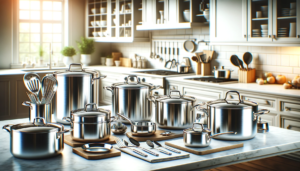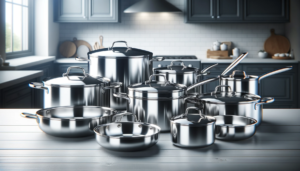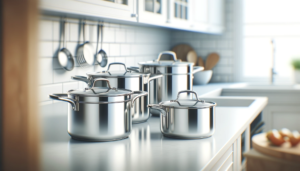Have you ever noticed strange icons printed on your pots and pans but wondered “what do these symbols on my stainless steel cookware actually mean?”
You’re not alone – the markings seem akin to a secret code.
In fact, this is a visual language conveying helpful details about the steel itself, cooking performance, safety add-ons, care recommendations, and more.
Let’s dive in to decode the top stainless steel cookware symbols so you can shop smarter.
What Do the Symbols on Stainless Steel Cookware Mean?

The symbols on stainless steel cookware refer to details about the type of steel used, production codes indicating quality ratios, performance features like 5-ply construction or Thermospot technology, capability symbols for dishwasher/oven safety, callouts for safety certifications like PFOA-free, care recommendations against abrasives, and more.
In short, this is a visual language conveying helpful specifics when shopping for pots and pans.
We’ll explore the most common stainless steel cookware symbols more in depth below.
But first, this decoder ring breaks down the basics of what these little images, numbers, and phrases actually communicate.
Types of Stainless Steel

Stainless steel is a commonly used material for cookware due to its durability, longevity, and resistance to corrosion and rust.
There are a few main types of stainless steel used in most cookware.
Grade 304 stainless steel contains approximately 18% chromium and 8% nickel.
This is a versatile, food-grade steel that resists corrosion.
Pots and pans made from grade 304 stainless steel are durable and easy to clean.
The 18% chromium creates a chromium oxide layer that prevents rust and stains, while the 8% nickel gives the steel additional corrosion resistance.
Grade 304 stainless steel cookware stands up well to a wide range of cooking tasks, from simmering sauces to frying eggs.
It’s an excellent all-around option for most home kitchens.
Grade 316 stainless steel contains about 16% chromium, 10% nickel, and 2% molybdenum for increased resistance to salt and acidic foods.
The addition of molybdenum gives grade 316 extra protection from pitting and corrosion caused by salty or acidic foods like tomatoes, vinegar, and broths.
As such, grade 316 stainless steel pans are ideal choices for tasks like making tomato sauce, canning foods, cooking brothy dishes, and preparing ceviche or other foods with citrus.
With the elevated level of corrosion protection, grade 316 stainless steel pans may come at a higher price but offer excellent longevity.
Grade 430 stainless steel contains 17% chromium but no nickel, making it magnetic and more affordable but less stain and rust resistant.
Grade 430 stainless steel cookware still provides a durable option for most everyday cooking.
But the lack of nickel means it’s slightly less resistant to rust and stains over time, especially when exposed to salt, acids, or certain cleaners.
Proper care is important for preventing discoloration.
The magnetic properties make grade 430 stainless steel pans compatible with induction cooktops.
So this can be a good affordable starter option for induction users.
While grade 430 won’t be as indestructible as grade 304 or 316 pans, with proper maintenance they can still deliver reliable everyday performance.
Knowing the type of stainless steel can give insight into the quality, durability, and ideal uses for the cookware.
Consider whether you’ll be cooking many acidic or salt-heavy foods before deciding between grade 304 and 316 stainless steel.
And look at grade 430 stainless as an induction-friendly budget pick requiring more careful maintenance.
Production Process Symbols

Some common numbers and codes refer to the production process for stainless steel rather than the steel grade itself.
For example, 18/10 and 18/8 stainless steel contains 18% chromium and either 10% or 8% nickel, respectively.
The ratio gives insight into the balance of metals used to make the steel more resistant to corrosion and rust.
An 18/10 stainless steel pan has a slightly higher percentage of nickel than 18/8 stainless steel.
In most cases, either option contains enough nickel to deliver high corrosion resistance and durability.
Brand name stainless steel designations work similarly to production ratio codes.
Companies will create their own branded steel names as a mark of quality.
For example, All-Clad may label their cookware as 18/10 stainless steel while Cuisinart uses a branded name like 18/10 stainless steel.
While the ratios still give some useful insight into the metal composition, branded names are also partly marketing language linking the steel to a trusted brand.
So an 18/10 stainless steel pan from All-Clad offers the same composition as an 18/10 pan from Cuisinart or other brands.
The branding aims to highlight production consistency and quality control behind a well-known name.
Performance Symbols

Beyond information about the steel itself, many stainless steel pans will contain symbols and codes highlighting performance features.
One common icon is a stack of lines shown on the bottom or sides of a pan.
This indicates how many layers or plies were used in the cookware’s construction.
More layers can improve heating conductivity for faster, more even heating and longer retention of heat.
For example, a five-ply pan contains five bonded layers of metal in areas like the base.
The layers typically consist of materials like aluminum or copper sandwiched between stainlesssteel for optimal reactivity.
Five-ply cookware brings professional-grade performance within reach of home cooks.
Another popular feature is something called Thermospot technology, typically displayed on a pan with a small red circle on the base.
This refers to a heat-sensitive area that changes color when the pan reaches an optimal preheating temperature before cooking.
For example, the red dot may turn solid red once the pan is hot enough for proper searing or frying.
This helps regulate temperature for consistent cooking results.
Rather than guessing if a pan is fully preheated, the color change of the Thermospot provides a reliable visual indicator.
Feature Symbols
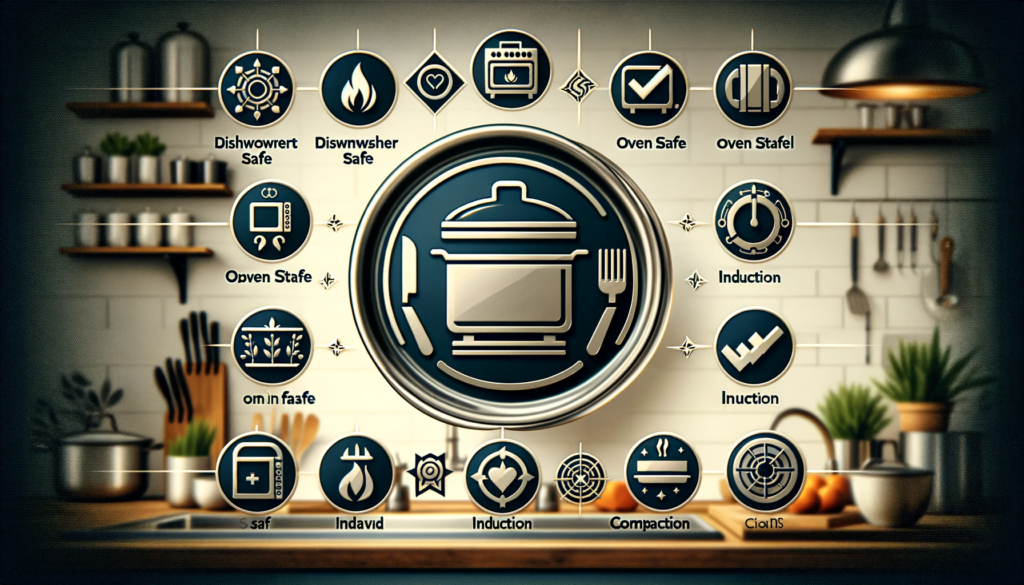
There are a range of symbols used to call out various features stainless steel cookware may possess.
One important one to look for is a dishwasher safe icon, typically showing an image of a dishwasher.
This indicates the cookware is approved for cleaning in a dishwasher without damage to the finish.
Hand washing is still recommended for longest lifespan, but the dishwasher safe symbol gives flexibility for busy schedules.
Other common icons will showcase oven safe and broiler safe status, displaying a maximum temperature and/or an image of an oven or broiler.
This notes if and how the stainless steel cookware can transition from stovetop to oven for ease of baking, roasting, broiling, and more.
Cookware also displays what types of stovetops it works with through compatible symbols, like induction, gas flame, electric coil, ceramic, etc. induction capability is especially important to note for stainless steel pans.
Other features called out via symbols include impact-bonded bases for even heating, encapsulated bases to prevent warping, ergonomic handles, pour spouts, measuring lines, lidsincluded, and more.
This visual language makes it easy to understand the pans’ capabilities at a glance.
Safety Symbols
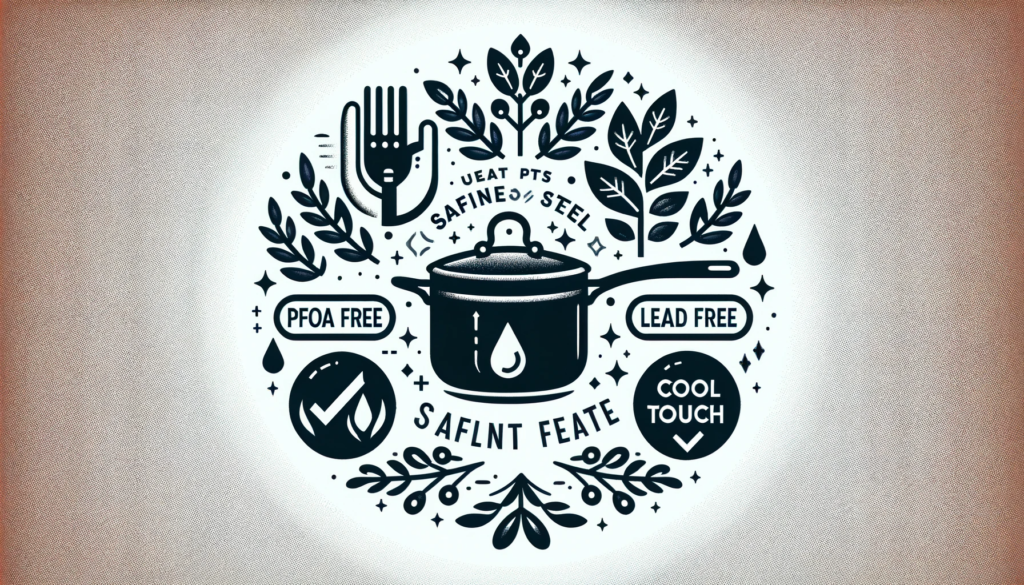
When choosing cookware, safety is also an important factor.
Stainless steel pan symbols communicate safety features as well.
“Cool touch” handles use visual language depicting a hand touching a handle to signal that the handles stay relatively cool while the cookware heats up during cooking.
This reduces the risk of accidental burning from touching hot metal.
It’s an important detail for cooks handling hot pans during stirring or plating.
Many pans also display symbols indicating they are PFOA free or lead free, calling out the absence of those potentially harmful chemicals in the production process.
While stainless steel alone offers food safe properties, these symbols provide extra confidence by voluntarily addressing concerns over modern non-stick coatings or components in other cookware materials.
For health-conscious consumers, the PFOA free and lead free callouts bring peace of mind.
Care Symbols

To keep stainless steel cookware looking and performing its best for many years, proper care is essential.
That’s why there are symbols indicating care recommendations and limitations.
One important one to note is an icon of a fork, knife, and spoon crossed out.
This means not to use metal utensils, as they can damage the cooking surface over time leading to scratches and pits.
Other symbols will display warnings not to use abrasive cleaners or scouring pads, as they too can erode cookware over time.
Following the care recommendations preserves the appearance and longevity of the stainless steel.
By understanding the language of stainless steel cookware symbols, it becomes much easier to shop for pans.
You can decode details about the steel grade, performance capabilities, features, safety add-ons, and proper care for them.
With so many options on the market with overlapping terminology and markings, let the symbols guide you to the right cookware to suit your cooking needs and expectations.
Whether you prioritize budget, induction capability, high heat retention, or other aspects, the symbols help cut through the noise.
Conclusion
By understanding this visual language, stainless steel cookware symbols transform from mysterious letters and images into clear guidance for selecting optimal cookware.
Let the symbols point you toward pans matching your priorities – whether safe non-stick release, lightning-quick heating, induction stovetop compatibility, or other must-haves features for your kitchen.
With this decoder ring for stainless steel markings, you can shop with confidence and find cookware as durable and multi-functional as its cryptic symbols imply.
